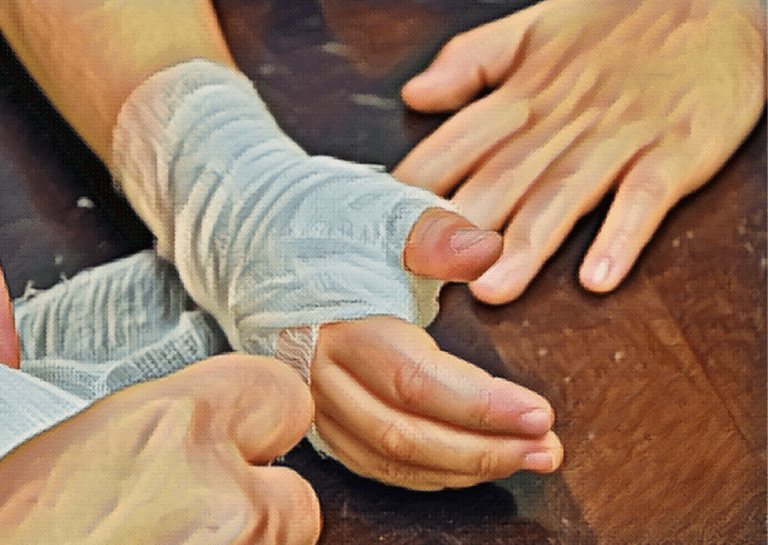Infants and young children are prone to many different types of minor injuries from everyday hazards and activities. Common injuries include blunt trauma, penetrating trauma, and burns. Minor injuries, as opposed to major injuries, generally include incidents that don’t lead to broken bones, hospitalization, surgery, or potential death. They can often be managed at home with first aid and medication or might require a trip to the doctor.
This article discusses the different types of minor injuries that parents can encounter and offers information on how to manage them if and when they arise.
Table of contents
Types of minor injuries and causes
Minor injuries are a common consequence of many everyday childhood activities, such as exploration, outdoor play, and sports. Injuries of any kind can be worrying for parents and caregivers, especially when they affect infants and young children.
Understanding the type of injury you’re dealing with can help you decide what steps to take in terms of treatment and management. This can also be helpful when deciding whether it’s best to treat the injury at home or take the child to a doctor.
- Blunt trauma: Blunt trauma is the most common type of pediatric trauma, accounting for 90 percent of all cases. Most of the time, blunt trauma injuries are mild to moderate in severity. Blunt trauma refers to injuries caused by forceful impact against a part of the body, such as the head, neck, chest, abdomen, or extremities. It can be caused through impact against a hard surface or by coming into contact with a blunt object. Blunt trauma can occur if a child falls over, hits their head, is hit by another child during rough play, or is hit with a ball or bat while playing sports.
- Penetrating trauma: Penetrating injuries occur when the body is pierced by a sharp object and/or left with an open wound. Penetrating trauma is more likely to be serious in nature than blunt trauma and may require surgical intervention. There is an added risk of infection when it comes to open wounds. Like blunt trauma, penetrating trauma can affect the head, neck, chest, spine, abdomen, and extremities. Examples include minor cuts, scrapes, impalements, and puncture injuries.
- Minor burn injuries: The severity of a burn injury depends on how deeply it penetrates the skin and how much surface area it covers. According to the American Burn Association, minor burns in children aged below 10 are defined as superficial/second-degree burns that cover less than 10 percent of total body surface area, or full-thickness/third-degree burns that cover less than 2 percent of total body surface area. A burn can only be considered minor if it is an isolated injury, it does not involve the face, hands, perineum, or feet, it does not cross major joints, and it is not circumferential (covering the entire circumference of a limb or extremity). Children can sustain burns from hot water, exposed flames, or electrical cables.
Treatment
Minor injuries can usually be managed at home by parents or caregivers and don’t often require medical treatment.
Minor burn injuries: Treating burns consists of removing any clothing or debris from the affected area, cooling the skin to prevent further damage, cleansing and dressing the skin, and managing the pain if necessary.
- Cool the skin with room temperature or cold tap water. You can do this by either running water over the affected area or placing damp cloth/gauze on the burnt skin.
- Avoid placing ice on burns as this can cause further tissue damage.
- It is also best to avoid using disinfectants on burn wounds. Instead, simply use gentle soap and water.
- Only partial-thickness and full-thickness burns need to be dressed, while superficial burns do not.
Blunt and penetrating trauma injuries: Minor blunt trauma injuries usually require no specific treatment and can resolve themselves. If the child is in pain, you can provide relief using appropriate pain medication for their age and by applying ice to the injury. For minor penetrating injuries like cuts, scrapes, and small wounds, basic first aid is sufficient. Ensure any open wounds are cleaned using a saltwater solution and protect the wound using a bandage [6]. Ensure the wound is kept clean and monitor it as it heals.
Should you see a doctor?
With minor injuries, it can be difficult to know if or when to see a doctor. Pay attention to the following vital signs and functions to determine whether or not your child needs medical attention for their injury:
- Airways
- Breathing
- Circulation
- Mental status
If the child’s breathing is normal, their heart rate is not abnormally high or low, and they don’t show signs of an altered mental status and are fully conscious, then they most likely won’t require hospitalization.
Superficial burns rarely require medical attention, but partial-thickness and especially full-thickness burns should be checked by a doctor.
If you are in doubt, it’s always best to see a doctor.
References
- Weiss AK, Lavoie ME, Tay KYE. A general approach to the ill or injured child. In: Fleisher & Ludwig’s Textbook of Pediatric Medicine, 8th ed, Bachur RG, Shaw KN (Eds), Lippincott Williams & Wilkins, Philadelphia 2021. p.26.
- Schonfeld D, Lee LK. Blunt abdominal trauma in children. Curr Opin Pediatr. 2012 Jun;24(3):314-8. doi: 10.1097/MOP.0b013e328352de97. PMID: 22450250.
- Cotton BA, Nance ML. Penetrating trauma in children. Semin Pediatr Surg. 2004 May;13(2):87-97. doi: 10.1053/j.sempedsurg.2004.01.004. PMID: 15362278.
- Baxter CR. Management of burn wounds. Dermatol Clin. 1993 Oct;11(4):709-14. PMID: 8222354.
- Pushkar NS, Sandorminsky BP. Cold treatment of burns. Burns Incl Therm Inj. 1982 Nov;9(2):101-10. doi: 10.1016/0305-4179(82)90056-0. PMID: 7150995.
- Fernandez R, Griffiths R. Water for wound cleansing. Cochrane Database Syst Rev. 2012 Feb 15;(2):CD003861. doi: 10.1002/14651858.CD003861.pub3. PMID: 22336796.
